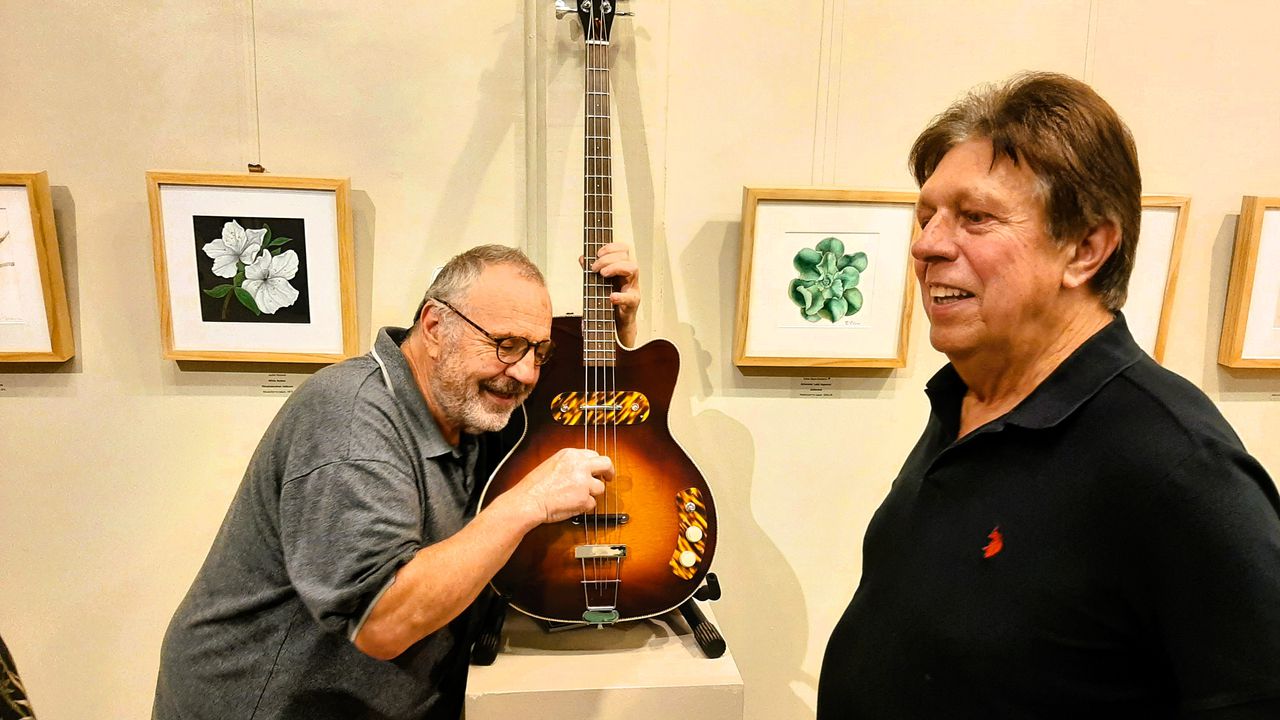5 things to know about an Alabama luthierâs âguitar odysseyâ
You might be cool. But you’re not “a former member of the Byrds and the Flying Burrito Brothers just wrote a foreword to a new book about you” cool. Roger Fritz is.
Once upon a time, as a student at Murphy High School in Mobile, he was among the countless American teens set afire by the British Invasion and the answering surge of domestic rock, playing Beatles, Ventures and Paul Revere & The Raiders covers in garage bands. But his interest in the instruments was as big as his interest in the music they made. He’d already begun taking things apart to see how they worked, tinkering to improve them, and building his own.
In the decades to come, he’d work for Gibson guitars and build a line of Fritz Bros. guitars endorsed by blues legend Roy Buchanan, a demanding player. He’d see his instruments played by the likes of George Harrison and The Bangles. He’d collaborate with Grammy-winning producer Bill Bottrell, and he’d become essential to the survival of the vintage Kay brand of instruments.
All of this provided plenty of grist for Willie G. Moseley, a guy who knows the territory. He’s a longtime senior writer for Vintage Guitar Magazine, and he’s written more than a dozen books, including authorized histories of Peavey Guitars and the Atlanta Rhythm Section. His latest is “A Luthier’s Life: The Guitar Odyssey of Roger Fritz.”
Bassist Mark Pfaff, left, and guitarist Warren Wolf couldn’t keep their hands off the exhibits at a recent book launch party for Roger Fritz, subject of the new book “A Luthier’s Life.”Lawrence Specker | [email protected]
If you’re a person whose hopes perk up at the words “guitar odyssey,” rest assured that Moseley’s book and Fritz’ story won’t let them down. Though the point of the book is not to make us jealous of Roger Fritz, it provides plenty of reasons to be envious. Some of them:
The foreword is by Gene Parsons. Yes, that Gene Parsons. A member of the Byrds and the Flying Burrito Brothers. Also the inventor of a guitar gizmo called the StringBender, which allows a conventional electric guitar to emulate some of the sounds of a pedal steel guitar.
Parsons’ introduction isn’t long, but he doesn’t mess around. “I am pretty certain Roger Fritz knows more about guitars and the history of the instrument than just about anyone in the world,” he writes, later adding: “If you are a guitar enthusiast, and have any interest in the design and building of the instrument, ‘A Luthier’s Life’ will be a must for your library and an absolute joy to read.”
Roy Buchanan endorsed his work.
In the ‘80s, Fritz began tailoring guitars to the specific demands of Roy Buchanan, a one-of-a-kind blues player who could coax unearthly sounds out of a Fender Telecaster. Fritz had already been building Telecaster-style guitars that were more robust and sonically complex, and that’s what Buchanan was looking for. The collaboration led to the creation of the Roy Buchanan Bluesmaster guitar built in Mobile by Fritz Bros. Guitars, founded with Roger’s brother John. Buchanan’s tragic death in 1988 cut the promising endorsement deal short.
George Harrison sent him a nice letter.
It had been Buchanan’s idea to send one of his signature models to former Beatle George Harrison, and Harrison’s response was enthusiastic. He sent back a letter saying, in part, that “I haven’t seen such a well-crafted guitar for years.” Sadly, the letter was dated Aug. 13, 1988, the day before Buchanan died. But some of the music lives on: There are still video clips on YouTube of Buchanan showing off his signature instrument. There’s also one of Harrison playing his on “Taxman,” though some guy named Eric handles lead guitar on that particular tune.
There are more names to drop.
The Roy Buchanan models also found their way into the hands of Vicki Peterson and Susanna Hoffs of The Bangles; Fritz made a unique 12-string version for Petersen. Other players included Willie Nelson guitarist (and Baldwin County resident) Jody Payne, seen playing one at Farm Aid, Gary Moore and Steve Cropper. As a musician, Fritz began working with Mobile native Shelby Lynne as she worked toward her breakthrough 1999 album “I Am Shelby Lynne,” That brought him into contact with Grammy-winning producer Bill Bottrell, whose credits include work with everyone from Michael Jackson and Madonna to Tom Petty and Sheryl Crow; work with Bottrell took Fritz to California, where Bottrell and Fritz continued to work together well after Lynne’s album was released.
He helped save a historic brand.
As Fritz was starting out in the ‘60s, Kay Musical Instrument Co. was one of a number of established American instrument companies competing for a share of the growing, rapidly changing market for rock instruments. Where Gibson and Fender endured, Kay and others succumbed to foreign competition and bewildering changes in ownership. In the 2000s, Fritz lent his skills as a craftsman to a revival of the Kay name. A large portion of the book deals with this portion of Fritz’ “guitar odyssey,” and for those interested in guitars it’s a deep dive into what made Kay different and what portions of the Kay heritage (such as its distinctive electric bass) Fritz worked to save. Though Fritz is mostly retired these days, you can still order handmade guitars from Fairhope-based Fritz Bros., including Bluesmaster-style models and a Fritz Bros. bass that’s “an improved replica of an early Kay electric bass.”
“A Luthier’s Life” can be ordered through fritzbrothersguitars.com and is available at Mobile’s Haunted Book Shop and other bookstores.
